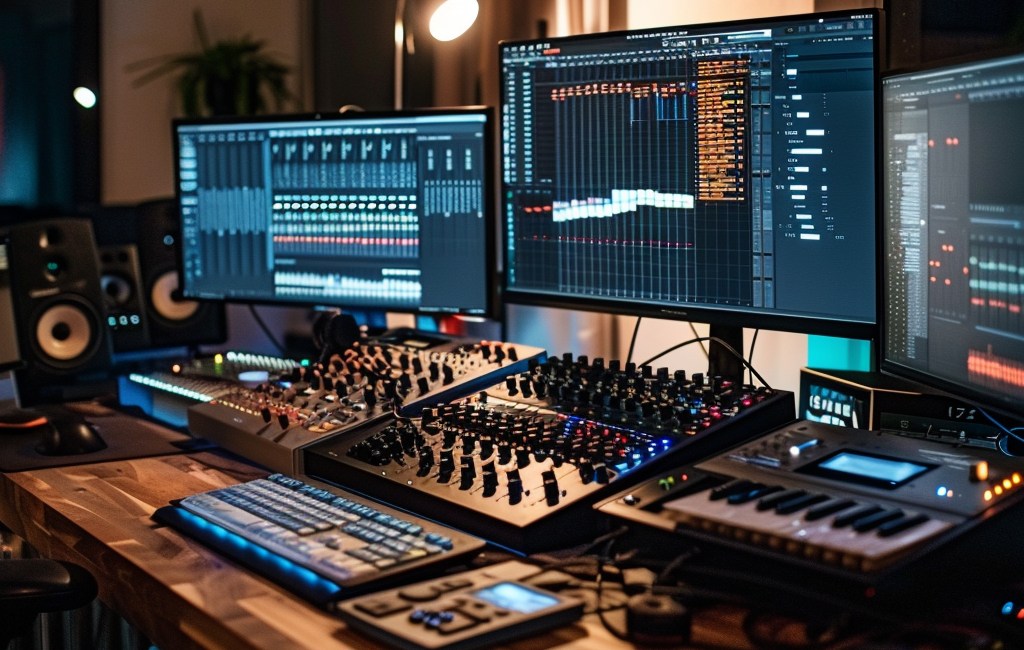Elements of a Video: Crafting Engaging Content with Visuals, Sound, and Script

The creation of a compelling video hinges on the skillful combination of various elements. Text, audio, images, raw footage: all must come together. These elements are the building blocks that, when woven together, produce an engaging narrative and memorable visual experience. Lets explain how these elements work in more detail.
Static images and live-action footage form the visual backbone, creating the scenery and action that catch the viewers' attention. The use of kinetic titles provides dynamic text animations that guide viewers through the video, highlighting important messages and adding to the storytelling impact.
Background music and voice-over work in tandem to set the tone and convey the video's emotional depth. The background music underscores the visuals, creating an auditory landscape that can intensify feelings or accentuate the pacing of the video. Meanwhile, a carefully written script ensures that the voice-over not only communicates the core message but also resonates with the audience, delivering information in a clear and persuasive manner.
Finally, the incorporation of graphics and visual effects can greatly enhance a video's informational and aesthetic appeal. Graphics can simplify complex information, making it more digestible for the audience, while visual effects can add a layer of polish and sophistication to the video, capturing and maintaining the viewer's attention. Each element must be meticulously crafted and balanced to create a harmonious and effective video.
Video Conceptualization
The process of video conceptualization is where the core ideas are formed and developed into a tangible plan. It involves meticulous planning and creative thought to ensure the final video meets its intended purpose.
Ideation
Ideation is the creative process of generating, developing, and communicating new ideas. It's where the underlying vision for the video is shaped. A successful ideation phase usually includes:
- Brainstorming sessions: Teams gather to pitch various ideas, themes, and concepts.
- Target audience analysis: Detailing the demographic and psychographic profiles of the intended viewers.
- Purpose definition: Clearly stating the video's objective, whether for education, entertainment, marketing, or information.
- Visual style selection: Deciding on the aesthetic direction including color schemes, lighting, and visual effects.
Script Development
Script development transforms the initial ideas into a structured narrative. This subsection involves:
- Creating an outline: Organizing the major points or storyline in a logical order.
- Writing a draft: Developing dialogue, on-screen text, and stage directions.
- Iterative revisions: Refining the script through multiple drafts to enhance clarity and impact.
- Finalization: Locking the script to provide a blueprint for production.
Visual Elements

Visual elements are the cornerstone of a video's appeal, capturing the viewer's attention through imagery and motion. They consist primarily of still images and video footage, each contributing uniquely to the story being told.
Images
Images serve as powerful visual components that can convey complex ideas quickly and effectively. They include:
- Photographs: High-quality photos can add depth and reality to the video.
- Illustrations: Creative and stylized, illustrations can present concepts in a more abstract or whimsical manner.
Importantly, the resolution and composition of images are vital in maintaining a professional appearance.
Footage
Video footage is the dynamic aspect of visual elements, offering movement and a narrative flow. It encompasses:
- Live-action footage: Real-world scenes recorded with a camera, providing authenticity and relatability.
- Animated sequences: Computer-generated or hand-drawn animations that can illustrate scenarios that may be impossible or impractical to film.
Using a diverse range of shots, such as wide, medium, and close-up, adds visual interest and supports storytelling.
Dynamic Text
Dynamic text in videos serves to engage viewers and highlight key information. This text often animates onto the screen, enhancing the visual storytelling.
Kinetic Titles
Kinetic titles are animated text elements that appear in motion as part of a video. These titles capture attention by combining movement with textual information. They typically follow these characteristics:
- Visibility: Bold fonts and contrasting colors for clear readability.
- Timing: Synced with video pacing and auditory elements to maintain flow.
- Motion: Designed with a variety of animations like fades, slides, or spins.
- Purpose: Used to emphasize important points or to introduce new segments.
In practice, kinetic titles may appear as:
| Moment in Video | Animation Type | Function |
|---|---|---|
| Intro | Fade-in | Introduce topic |
| Transition | Swipe effect | Move to next section |
| Highlight | Pop-up | Emphasize a key point |
| Outro | Slow zoom | Conclude the presentation |
The creativity of kinetic titles lies within the editor's choice of animation and its strategic placement. They play a crucial role in keeping the viewer engaged while enhancing the communication of the video's core message.
Audio Elements

Audio elements are integral to a video's effectiveness, with background music setting the tone and voice overs providing narrative clarity.
Background Music
- Function: Background music serves to set the mood and tone of the video, often steering the emotional response of the audience.
- Selection: Choosing the right music involves considering the video's theme, pacing, and the emotions one intends to evoke. The YouTube Music Library is an excelent free catalogue to get you started. All pieces are guaranteed to be copyright-free and there is a good selection of all the major styles one would want.
Voice Over
- Purpose: A voice over provides specific information, enhancing the audience's understanding of the video content.
- Characteristics: The voice should be clear, well-paced, and suited to the video's audience and objective.
Graphic Design
Graphic design in videos enhances visual storytelling and reinforces the message. It involves the creation and integration of various visual elements that capture attention and communicate effectively.
Graphics
Graphics play an essential role in video production. They can include items such as logos, icons, charts, and text elements. These graphics help to support and accentuate the narrative of the video. Properly designed graphics can convey complex information quickly and efficiently.
-
Logos: They establish brand identity and should be placed strategically without overwhelming the content.
-
Icons: These are used to communicate concepts and ideas at a glance, often simplifying complex ideas into an easily recognizable format.
-
Charts and Graphs: When presenting data and statistics, charts and graphs can illustrate points with clarity and impact.
-
Text Elements (Kinetic Titles): They not only display information but can also be animated to add energy and focus to key points.
The choice of colors, fonts, and the design style should align with the video's overall theme and messaging strategy. Graphic designers must consider how each element will look both in motion and at rest, ensuring consistency and readability across various viewing platforms.
